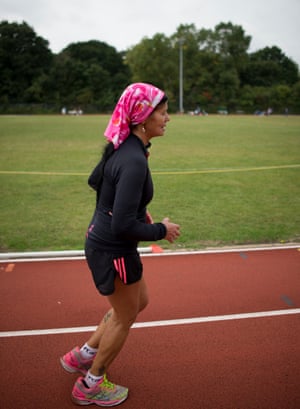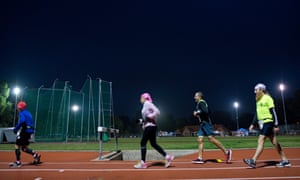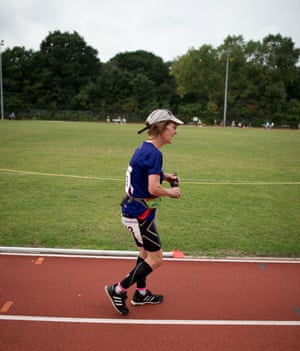The 24-hour race: ‘It is a battle with your mind’
‘I hallucinated, of course. I always do,” Pat Seabrook says. She is 76 and has spent the past 24 hours running round a 400m athletics track in Tooting, south London. She sits in the front seat of her car, peeling plasters off her toes. “At some point I began to think the white lines on the track were ropes, rising up around me, and I was pushing them away.” She laughs: “Usually I run with my friend and we take turns to hallucinate.”
Along with 44 other runners, Seabrook has just competed in the Sri Chinmoy Self-Transcendence 24-hour Track Race. Ultra-running, in which competitors take part in races longer than a marathon and often canadianpharmtabs.com 100 miles or more, is one of the fastest growing sports in the world, with new races launching all the time; the biggest ones have been forced to introduce lottery systems to cope with the numbers who want to enter. But part of the appeal of these races is that they usually take place amid some of the world’s most remote and scenic landscapes, such as the Sahara or the Rockies. Not around a track in Tooting.

The winner, James Stewart, runs a mind-boggling 160 miles over the course of the day. It’s hard to grasp, watching him plug away, lap after lap: 160 miles, without going anywhere. He could have run all the way to Cardiff, but he’s still here, on the track in Tooting.
Seabrook is the oldest competitor here and covers 83 miles during the race. “It’s not that great,” she says, pulling off another plaster. “Last year I ran 87.” As well as countless 24-hour races, she has also run 456 marathons. She didn’t even start running until her late 40s, when all her children had grown up and left home. “I needed something to keep me busy,” Seabrook says. “What else am I going to do on a Saturday?”
Yet in spite of her low-key attitude, something else is going on here. The race was started almost 30 years ago by followers of the late Indian spiritual teacher Sri Chinmoy, who believed that running was integral to a spiritual life.
In 1977, Chinmoy started a marathon team, which began putting on races in New York and is now one of the biggest organisers of endurance events around the world. While most of the volunteers and organisers in Tooting are followers of his teachings, only one of the runners, Mahasatya Janczak from Poland, is part of the Sri Chinmoy team. He has done the race twice before. Does he find self-transcendence through it? “At moments, definitely,” he replies, a glint in his eye. “It’s really something. You can only understand it if you try it.”

Diana Celeiro has come all the way from Argentina for the race. It’s her second time here. Her husband, Gustavo, acts as her support crew. Most of the runners have someone who stands diligently by the track watching, offering encouragement, preparing snacks or helping with any issues that arise, from blisters to emotional breakdowns. Some of the support crews have brought tents; one family even has a motorhome parked up on the edge of the track. A few of the runners have no crew and have just set up a table on the grass – or, in one runner’s case, an ironing board – laden with their supplies.
Some supporters disappear home or to a hotel during the night for some sleep. Gustavo, though, stands vigilant throughout, always smiling. “This is different from running 100 miles in the mountains,” he says. “When you run 100 miles all around a track, it is a battle with your mind.”
I ask how his wife is, after completing a race like this. “Very quiet,” he says. “Almost dead.”
In Japan, monks on Mount Hiei run 1,000 marathons in 1,000 days in a effort to reach enlightenment. One of the monks once told me that the idea behind the constant movement is to exhaust the mind, the body, everything, until nothing is left and you are almost dead. “When you are nothing, then something – pop! – comes up to fill the space,” he said, miming a bubble popping. That something, he told me, is the vast consciousness that lies below the surface of our lives – a sense of oneness with the universe.

None of the runners here in Tooting vocalises it quite so lucidly, but there are glimpses of something deeper than PBs and course records. “Sometimes, you can get into that space; a few laps go by and you don’t realise it,” Paul Corderoy says.
“There’s a nowness to it, that’s for sure,” says Jamie Holmes, a management consultant who lives less than a mile from the track. He has recently completed the legendary Spartathalon ultra-marathon in Greece, which is 153 miles. When I ask why he keeps doing such long races, he says he can’t really explain it, but thinks he’s trying to break himself. “I suppose I’m trying to find my limit,” he says. “Maybe when I find it, I’ll stop.”
Shankara Smith, the race director, says that the biggest challenge is yourself. “Sri Chinmoy used to say it’s not mind over matter, but heart over mind. If you can’t silence that mind, then you can’t do it, because your mind will tell you you can’t. Here, you can’t tell yourself it’s you versus that mountain, because there is no mountain. It’s just you versus you.”
Smith has watched the race every year since it started in 1989, when her father was the race director. “I love it,” she says. “If you’re here at 3am, the city is quiet, nothing is going on, but on the track, the atmosphere is zinging. But also peaceful.”
I spend a few hours watching the runners lap the track. Everyone seems in good spirits; it’s a chilly, overcast afternoon, which is fine for the runners, and while a few have gone off fast at the front, most are running well within themselves, chatting to each other and joking with the officials. I decide to get some food and rest.
Driving back to the track at 3am, I find it hard to imagine they are all still going but, sure enough, out on the floodlit track 15 hours after they started, the runners are still going around and around. About 10 (mostly those who started at the front in the first few hours) have dropped out.

Some of those left look as if they’re in pain, their running styles twisted and contorted. Many are walking, but even that looks difficult. One man with a shaven head is walking slowly with his fists clenched; he looks as if he wants to punch someone. They have nine hours left to go.
Some people stand out, calm and composed. One of them is 68-year-old Ann Bath. She’s not very fast, she’s a little bent over, but she is unrelenting. While others occasionally stop for a massage, or to eat something, she presses serenely on, never stopping. In the end, she runs an incredible 116 miles, an age-group world record.
Holmes, the management consultant, smiles when he sees me again. He is now walking gingerly and his knee is heavily strapped. “I think I’ve found my limit,” he says. At the end of every lap, the runners pass a tent full of people with big clipboards and lists of numbers. The lap counters have to wave to their runner each time to show they’ve registered the lap, and the runners usually wave back to double check their lap has been counted. As the hours progress, an intimacy builds up. They get to know each other well, and there’s lots of laughing and joking. The runners say it gives them a lift.

“Some races, you have a chip counter tied to your shoe,” one runner tells me, “but what I like about this race is that you have people doing it.”
Another runner and his counter are trying to name a new animal each lap. After a while, the runner, his brain frazzled, stops and leans on the table edge. “I can’t think of any more,” he says. “I’m done. No, wait, flamingo!” And, with that, he’s off again.
“You’re looking great,” one of the lap counters shouts to Holmes.
“You’re looking beautiful,” he replies, his dazed smile now fixed permanently across his face, perhaps shielding the pain. When I catch him along the back straight, he tells me he misses his friends. “Normally I run with friends,” he says. “Without them here to tell me to stop being an idiot, I can’t find the will to try running again.” So he walks. But he doesn’t stop.
Around the track, many of the support crews are sleeping on chairs or on the floor. Lauren Howes, whose boyfriend, Cameron Humphries, is doing his first 24-hour race, is struggling to understand what she’s doing here. “I don’t get it,” she says. “It’s like a cult. His heroes are not Brad Pitt or George Clooney, but some ultra-runner guy.”
“Kilian Jornet?” I venture. He’s just about the most famous ultra-runner I can think of; he runs up and down mountains.
“Yes, that’s it. He’s got four pairs of his shoes.”
Some of the crew are race veterans who can’t stay away. One tells me she was a marathon runner when someone at her club told her he had seen a race where people were eating sandwiches while they were running. “I didn’t believe it,” she says, “so I went to watch. I turned up in the morning and there was a group of people wandering around the track like zombies. I’ve been hooked ever since. If I’m not running, I’m crewing.”
Although at times it seemed that it would never come, finally, at just before midday, we get the bell marking the last five minutes of the race. For the final few laps, the runners are joined on the track by family and friends. Fathers run holding hands with their children, couples run, or walk, arm in arm. One man decides to start sprinting, his support crew struggling to keep up, while another carries his young daughter. One woman, clearly in agony, is accompanied by her concerned husband and two teenage sons. When the hooter goes to signal the end, she bursts into tears. Others collapse on the ground where they are, or hug the nearest person. I find myself close to tears.
One runner, the shaven-headed man with the clenched fists – he didn’t unclench them the entire race – is walking back alone across the infield. I ask if he’s OK. He looks at me blankly for a moment, as though I’ve just appeared out of the ground. “I just need to lie down,” he says in the meekest voice I’ve ever heard.
And so it ends. I guess they’ll all go back to their jobs and people will ask them if they’re mad. “Why?” people will ask. “Why would you do such a thing?” And they’ll probably be unable to answer. But they’ll be back next year to do it all over again.
Source: Read Full Article


